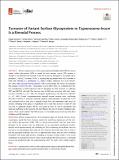Turnover of variant surface glycoprotein in Trypanosoma brucei is a bimodal process
Abstract
African trypanosomes utilize glycosylphosphatidylinositol (GPI)-anchored variant surface glycoprotein (VSG) to evade the host immune system. VSG turnover is thought to be mediated via cleavage of the GPI anchor by endogenous GPI-specific phospholipase C (GPI-PLC). However, GPI-PLC is topologically sequestered from VSG substrates in intact cells. Recently, A. J. Szempruch, S. E. Sykes, R. Kieft, L. Dennison, et al. (Cell 164:246-257, 2016, https://doi.org/10.1016/j.cell.2015.11.051) demonstrated the release of nanotubes that septate to form free VSG+ extracellular vesicles (EVs). Here, we evaluated the relative contributions of GPI hydrolysis and EV formation to VSG turnover in wild-type (WT) and GPI-PLC null cells. The turnover rate of VSG was consistent with prior measurements (half-life [t1/2] of ∼26 h) but dropped significantly in the absence of GPI-PLC (t1/2 of ∼36 h). Ectopic complementation restored normal turnover rates, confirming the role of GPI-PLC in turnover. However, physical characterization of shed VSG in WT cells indicated that at least 50% is released directly from cell membranes with intact GPI anchors. Shedding of EVs plays an insignificant role in total VSG turnover in both WT and null cells. In additional studies, GPI-PLC was found to have no role in biosynthetic and endocytic trafficking to the lysosome but did influence the rate of receptor-mediated endocytosis. These results indicate that VSG turnover is a bimodal process involving both direct shedding and GPI hydrolysis. IMPORTANCE African trypanosomes, the protozoan agent of human African trypanosomaisis, avoid the host immune system by switching expression of the variant surface glycoprotein (VSG). VSG is a long-lived protein that has long been thought to be turned over by hydrolysis of its glycolipid membrane anchor. Recent work demonstrating the shedding of VSG-containing extracellular vesicles has led us to reinvestigate the mode of VSG turnover. We found that VSG is shed in part by glycolipid hydrolysis but also in approximately equal part by direct shedding of protein with intact lipid anchors. Shedding of exocytic vesicles made a very minor contribution to overall VSG turnover. These results indicate that VSG turnover is a bimodal process and significantly alter our understanding of the "life cycle" of this critical virulence factor.
Citation
Garrison , P , Khan , U , Cipriano , M , Bush , P J , McDonald , J , Sur , A , Myler , P J , Smith , T K , Hajduk , S L & Bangs , J D 2021 , ' Turnover of variant surface glycoprotein in Trypanosoma brucei is a bimodal process ' , mBio , vol. 12 , no. 4 , e01725-21 . https://doi.org/10.1128/mBio.01725-21
Publication
mBio
Status
Peer reviewed
ISSN
2150-7511Type
Journal article
Description
This work was supported by United States Public Health Service grant R01 AI035739 and funds from the Jacobs School of Medicine and Biomedical Sciences to J.D.B. and from United States Public Health Service grant 1S10OD021719-01A1 to the University of Georgia, which purchased the ImageStreamX Mk II. This work was also supported by the Wellcome Trust (grant 094476/Z/10/Z) for funding the purchase of the TripleTOF 5600 mass spectrometer at the BSRC Mass Spectrometry and Proteomics Facility.Collections
Items in the St Andrews Research Repository are protected by copyright, with all rights reserved, unless otherwise indicated.

